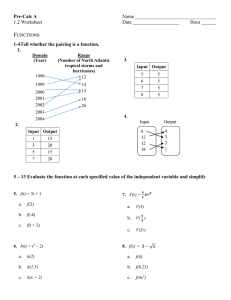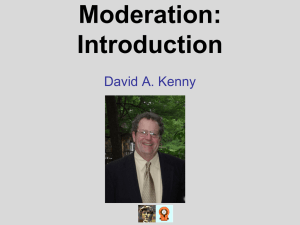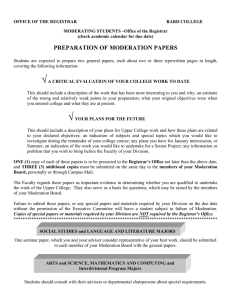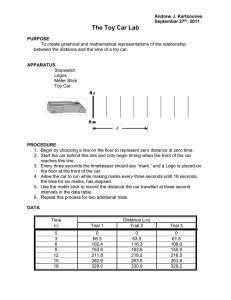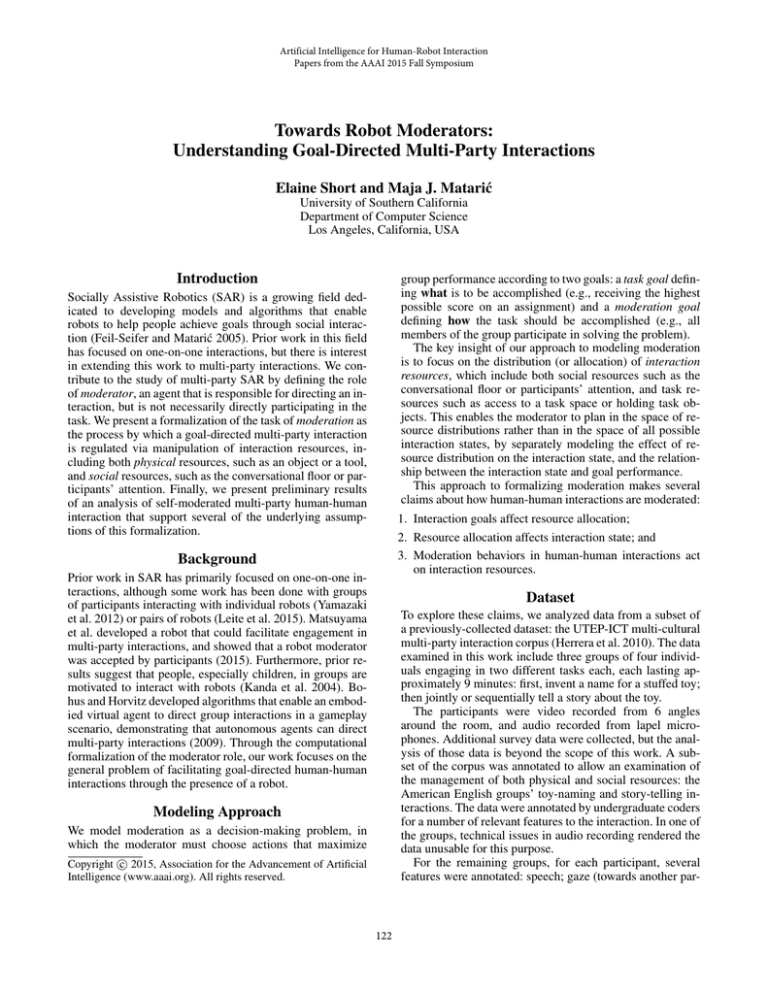
Artificial Intelligence for Human-Robot Interaction
Papers from the AAAI 2015 Fall Symposium
Towards Robot Moderators:
Understanding Goal-Directed Multi-Party Interactions
Elaine Short and Maja J. Matarić
University of Southern California
Department of Computer Science
Los Angeles, California, USA
Introduction
group performance according to two goals: a task goal defining what is to be accomplished (e.g., receiving the highest
possible score on an assignment) and a moderation goal
defining how the task should be accomplished (e.g., all
members of the group participate in solving the problem).
The key insight of our approach to modeling moderation
is to focus on the distribution (or allocation) of interaction
resources, which include both social resources such as the
conversational floor or participants’ attention, and task resources such as access to a task space or holding task objects. This enables the moderator to plan in the space of resource distributions rather than in the space of all possible
interaction states, by separately modeling the effect of resource distribution on the interaction state, and the relationship between the interaction state and goal performance.
This approach to formalizing moderation makes several
claims about how human-human interactions are moderated:
Socially Assistive Robotics (SAR) is a growing field dedicated to developing models and algorithms that enable
robots to help people achieve goals through social interaction (Feil-Seifer and Matarić 2005). Prior work in this field
has focused on one-on-one interactions, but there is interest
in extending this work to multi-party interactions. We contribute to the study of multi-party SAR by defining the role
of moderator, an agent that is responsible for directing an interaction, but is not necessarily directly participating in the
task. We present a formalization of the task of moderation as
the process by which a goal-directed multi-party interaction
is regulated via manipulation of interaction resources, including both physical resources, such as an object or a tool,
and social resources, such as the conversational floor or participants’ attention. Finally, we present preliminary results
of an analysis of self-moderated multi-party human-human
interaction that support several of the underlying assumptions of this formalization.
1. Interaction goals affect resource allocation;
2. Resource allocation affects interaction state; and
3. Moderation behaviors in human-human interactions act
on interaction resources.
Background
Prior work in SAR has primarily focused on one-on-one interactions, although some work has been done with groups
of participants interacting with individual robots (Yamazaki
et al. 2012) or pairs of robots (Leite et al. 2015). Matsuyama
et al. developed a robot that could facilitate engagement in
multi-party interactions, and showed that a robot moderator
was accepted by participants (2015). Furthermore, prior results suggest that people, especially children, in groups are
motivated to interact with robots (Kanda et al. 2004). Bohus and Horvitz developed algorithms that enable an embodied virtual agent to direct group interactions in a gameplay
scenario, demonstrating that autonomous agents can direct
multi-party interactions (2009). Through the computational
formalization of the moderator role, our work focuses on the
general problem of facilitating goal-directed human-human
interactions through the presence of a robot.
Dataset
To explore these claims, we analyzed data from a subset of
a previously-collected dataset: the UTEP-ICT multi-cultural
multi-party interaction corpus (Herrera et al. 2010). The data
examined in this work include three groups of four individuals engaging in two different tasks each, each lasting approximately 9 minutes: first, invent a name for a stuffed toy;
then jointly or sequentially tell a story about the toy.
The participants were video recorded from 6 angles
around the room, and audio recorded from lapel microphones. Additional survey data were collected, but the analysis of those data is beyond the scope of this work. A subset of the corpus was annotated to allow an examination of
the management of both physical and social resources: the
American English groups’ toy-naming and story-telling interactions. The data were annotated by undergraduate coders
for a number of relevant features to the interaction. In one of
the groups, technical issues in audio recording rendered the
data unusable for this purpose.
For the remaining groups, for each participant, several
features were annotated: speech; gaze (towards another par-
Modeling Approach
We model moderation as a decision-making problem, in
which the moderator must choose actions that maximize
c 2015, Association for the Advancement of Artificial
Copyright Intelligence (www.aaai.org). All rights reserved.
122
cation of interaction resources affects the state of the interaction; that moderation behaviors act on interaction resources;
and that the goals of the interaction affect resource allocation. In a preliminary analysis of the UTEP-ICT dataset, we
find support for further investigation of these hypotheses, encouraging further work using this model. This future work
will include formal statistical analysis using a larger dataset,
the analysis of gaze patterns in the interaction, and a more
detailed study of the effect of holding the toy on the conversational floor. The results of the analysis will be used to
parameterize an initial model of moderation for this type of
task, to be implemented on a robot and tested with groups
of adults in a task analogous to those used in the UTEP-ICT
dataset.
Figure 1: Proportion of time with [n] speakers in 100ms intervals.
Acknowledgments
ticipant or the toy); and toy-related gestures, including holding the toy, bidding to hand the toy off, or bidding to receive
the toy.
Additionally, an informal annotation was performed of
types of speech behaviors, such as questions, interruptions,
and backchannels. The analysis of these features will be
used to develop preliminary models for the task and moderation goals, to define a set of moderation behaviors, and
to model the relationship between conversational resources
and world state.
This work was supported by the National Science Foundation (Expeditions in Computing IIS-1139148, CNS0709296, REU Supplements, and GRFP). The authors thank
David Traum for providing advice and access to the UTEPICT dataset, and Rhianna Lee, Jackson Burgess, Joyce Su,
and Stephanie Yi for their help in data coding.
References
Bohus, D., and Horvitz, E. 2009. Models for Multiparty
Engagement in Open-World Dialog. Comput. Linguist. 225–
234.
Feil-Seifer, D., and Matarić, M. J. 2005. Defining socially
assistive robotics. In Proc. 2005 IEEE 9th Int. Conf. Rehabil.
Robot., volume 2005, 465–468.
Herrera, D.; Novick, D.; Jan, D.; and Traum, D. 2010. The
UTEP-ICT cross-cultural multiparty multimodal dialog corpus. In Multimodal Corpora Work. Adv. Capturing, Coding
Anal. Multimodality (MMC 2010).
Kanda, T.; Hirano, T.; Eaton, D.; and Ishiguro, H. 2004. Interactive Robots as Social Partners and Peer Tutors for Children: A Field Trial. Human-Computer Interact. 19(1):61–
84.
Leite, I.; McCoy, M.; Ullman, D.; Salomons, N.; and Scassellati, B. 2015. Comparing Models of Disengagement in
Individual and Group Interactions. In Proc. Tenth Annu.
ACM/IEEE Int. Conf. Human-Robot Interact. - HRI ’15, 99–
105. New York, New York, USA: ACM Press.
Matsuyama, Y.; Akiba, I.; Fujie, S.; and Kobayashi, T.
2015. Four-participant group conversation: A facilitation
robot controlling engagement density as the fourth participant. Computer Speech & Language 33(1):1–24.
Yamazaki, A.; Yamazaki, K.; Ohyama, T.; Kobayashi, Y.;
and Kuno, Y. 2012. A Techno-Sociological Solution for
Designing a Museum Guide Robot : Regarding Choosing
an Appropriate Visitor. In ACM HRI’ 12, Boston, Massachusetts, USA, 309–316. New York, New York, USA:
ACM Press.
Results
In a preliminary, qualitative, analysis of this dataset, we find
some support for the model assumptions:
Interaction goals affect resource allocation: We find differences in participant behavior between the naming and
story tasks. In the naming task, where the participants are
only given the task goal of agreeing on a name, we observed
shorter turns and more interruptions. In the story task, where
participants were also instructed that they should tell the
story jointly, we find longer turns and more even participation. As seen in Figure 1, the story task had more time with
only one speaker, and less time with two or more simultaneous speakers.
Resource allocation affects interaction state: Additionally, we find that the distribution of resources affects the interaction state: as seen in Figure 2, most participants spoke
a greater proportion of the time when they held the toy. This
effect was stronger in the story task, suggesting that participants may have been deliberately using the toy to moderate
the interaction.
Moderation behaviors act on interaction resources: We
observed a number of moderation behaviors in the interactions acting on resources such as the conversational floor and
the toy. Open (not directed to a particular target) questions
were used to release the floor, directed questions were used
to pass the floor to an individual, and passing the toy, as discussed above, may have been used to regulate turns.
Conclusion
In this work, we propose a computational formalization of
moderation, from which we generate several hypotheses
about moderation in human-human interaction: that the allo-
123
Figure 2: Time spent speaking while holding the toy and while not holding the toy.
124

